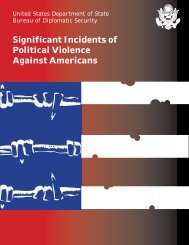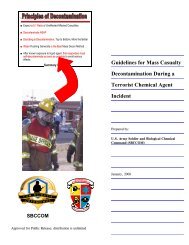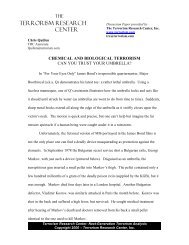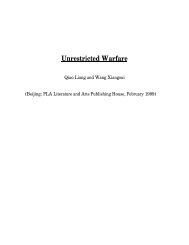Combating Proliferation of Weapons of Mass Destruction
Combating Proliferation of Weapons of Mass Destruction
Combating Proliferation of Weapons of Mass Destruction
Create successful ePaper yourself
Turn your PDF publications into a flip-book with our unique Google optimized e-Paper software.
Additional Views <strong>of</strong> Margo D. B. Carlisle, Steven Cambone, 31 Henry F. Cooper,William Schneider, Jr., and Henry SokolskiThe Commission's work has addressed a crucial issue <strong>of</strong> public policy and nationalsecurity—the organization <strong>of</strong> the Federal government to combat the proliferation <strong>of</strong>weapons <strong>of</strong> mass destruction and their means <strong>of</strong> delivery. The threat posed to the UnitedStates by proliferation has intensified dramatically in recent years. A recent independentreview <strong>of</strong> the proliferation threat led by former Secretary <strong>of</strong> Defense Donald H. Rumsfeldobserved that the threat has matured so rapidly, that the United States could be subjectedto WMD attack in the near future “with little or no warning.” 32 It is not surprising that this isso. The Commission has concluded that the efforts <strong>of</strong> the US government to combatproliferation today are neither effective nor command an appropriately high policy priorityin the Executive branch <strong>of</strong> government.The Commission's recommendations engage two broad areas <strong>of</strong> governmentorganization. The first is the organization <strong>of</strong> government departments and agencies toperform their respective functions in combating proliferation. The performance <strong>of</strong>government agencies in the implementation <strong>of</strong> their mission to combat proliferation isuneven. The effectiveness <strong>of</strong> some agencies such as the Department <strong>of</strong> State have shownsigns <strong>of</strong> improvement, while other agencies such as the Department <strong>of</strong> Energy havesuffered a vertiginous decline. In the case <strong>of</strong> the Department <strong>of</strong> Energy, fundamentalchanges in management <strong>of</strong> nuclear proliferation-related functions in the Department areneeded. We agree with the PFIAB's recommendation that an as an autonomous entity beformed either within the Department similar to the DOD's Advanced Research ProjectsAgency, or as an independent non-cabinet agency similar to the former Atomic EnergyCommission. We prefer either <strong>of</strong> these suggestions to the Commission's proposedreorganization under an assistant secretary. We agree that the performance <strong>of</strong>government departments and agencies is crucial to a successful government-wide effortto combat proliferation. From a programmatic perspective, the ability <strong>of</strong> the government tocombat proliferation will not necessarily be improved simply by applying additionalresources to existing programs. However, we believe that the Commission's organizationalrecommendations will enable departments and agencies to better employ existingresources, and effectively use additional resources if they become available in the futureto combat proliferation. Future administrations will benefit from the implementation <strong>of</strong>these recommendations.The second dimension <strong>of</strong> the Commission's recommendations concerns the managementand leadership <strong>of</strong> the interagency process. The Commission's recommends creation <strong>of</strong> anew position within the National Security Council staff to manage the interagencyapparatus to combat proliferation. The <strong>of</strong>ficial would be empowered with extraordinary31Nominated32Commission to Assess the Ballistic Missile Threat to the United States: Executive Summary,(Washington: GPO, 1998).173







